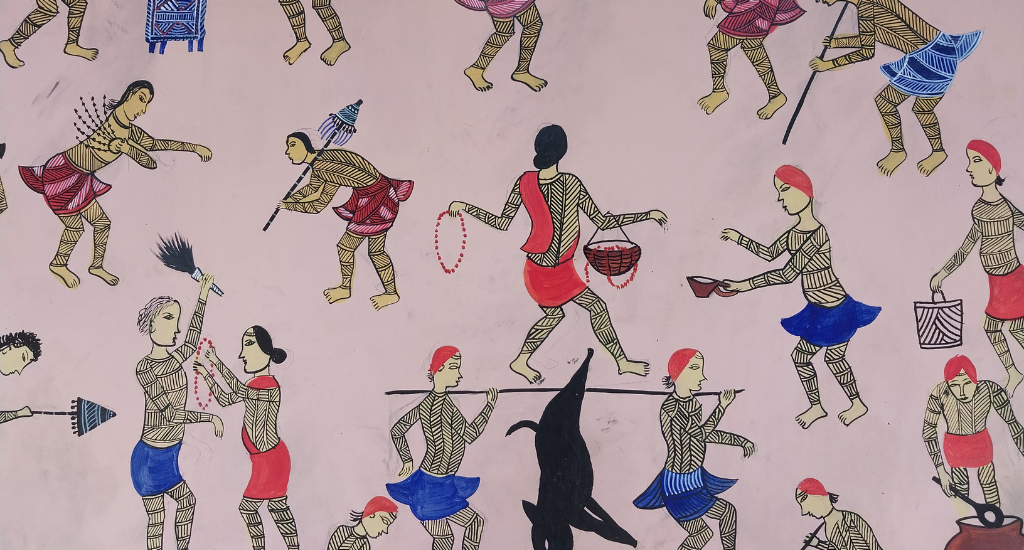
Family of woodcarvers preserves Chhattisgarh’s Muria Ghotul art
Despite the challenges and uncertainties, the legacy of talented artisans endures in the small village of Garh Bengal as a testament to the indomitable spirit of creativity.

Despite the challenges and uncertainties, the legacy of talented artisans endures in the small village of Garh Bengal as a testament to the indomitable spirit of creativity.
The rhythmic melody of wood being delicately carved harmonises with the laughter of children playing in a nearby school playground in Garh Bengal, a village in the Narayanpur district of Chhattisgarh.
In this bucolic setting, an art form has thrived, celebrated by the creation of shimmering black wooden statues, intricately designed face masks, and a deer’s visage, adorning the nooks and crannies of artisan Pandiram Mandavi’s modest home.

A particular wooden masterpiece captivates attention – an elegant portrayal of a Muria tribal boy named Chendru Mandavi etched onto the wall. Chendru, a legend in his own right, rose to global prominence in the 1960s, thanks to the Swedish director Arne Sucksdorff’s film “The Jungle Saga”.
Today, Garh Bengal, the Chhattisgarh village where Chendru’s life unfurled, carries forward the legacy of its talented woodcarvers and painters. Mandavi, a notable figure in the village, radiates pride when he shows his impressive wooden creation depicting Chendru.
For Mandavi, wood carving has been a labour of love for 35 years, and he humbly admitted to practising his craft barefoot. Inside a modest workshop beside his room, the floor is strewn with semi-finished wooden sculptures, one taking on the form of a crocodile.
Also Read: Alu Kurumba art depicts the tribes’ connection with nature

“The market for wooden items isn’t great, and government support is virtually non-existent,” Mandavi said. “The Chhattisgarh Handicraft Development Board used to purchase some of my items, but now it’s almost none. I can sell only a few masks in a year.”
His primary income comes from cultivating paddy, a livelihood made precarious due to erratic rains. “There are no irrigation facilities, forcing farmers to rely on the unpredictable monsoon,” he said.
Sitting on the floor nearby, Mandavi’s son Mansingh carves a stool. He shares his father’s passion for woodcarving. “I never felt like doing anything else and followed in my father’s footsteps,” he said.

However, life isn’t without its challenges for this father-son duo. The wood used for carving is bought from the forest department depot, and their preferred choice is teakwood. The masks are painstakingly painted to enhance their allure. Everything costs money.
Mandavi pointed out the depots are located in Narayanpur and neighbouring Kondagaon district. “Sometimes, we need a full truckload, and we have to make the journey to collect the wood. Masks are typically priced between Rs 1,500 and Rs 2,000.”
He also boasts another artist in his family. His son Baldev Mandavi has been studying sculpting at the Indira Kala Sangeet University in Khairagarh of Rajnandgaon district for the past six years.
Also Read: Mandala art and Kashmir’s shikara sorceress

Baldev extends his artistic talents to painting Muria Ghotul art on canvas, a craft that once adorned the walls of ghotuls – dormitories where tribal youths learned the rules of life. Narayanpur district boasted a significant number of ghotuls.
“Last year, the government renovated a few ghotuls, but the youth have become less interested. In the past, when village walls were made of mud, ghotul paintings flourished,” Mandavi said. At the village’s sacred grove or “devgudi”, there are two such paintings done by Baldev.
Mandavi noted that the encroachment of school education and mobile phone addiction has taken a toll on the Muria Ghotul art form. “As adolescents became engrossed in their studies, they slowly distanced themselves from songs and dances (which often took place in ghotuls after sundown),” he said.

Despite his best intentions, his efforts to teach the younger generation have failed. He recollected a visit to Delhi: “I wanted to teach, but no one turned up.”
At the home of artist Jairam Mandavi, another member of the family, four vibrant canvas paintings illuminate the courtyard. He aspires to showcase his work in Bhopal, where he initially mastered the Muria Ghotul art for about 20 days. In a unique blend, the artist incorporates elements of the Gond tribe’s art into his paintings.
“Once upon a time, wall art was commonplace on mud walls, a tradition that has gradually waned. However, if people want, they can still make them,” Jairam said.
Also Read: Why is Jharkhand’s Paitkar scroll art losing colour?

Painting, though a time-consuming endeavour, captivates Jairam’s devotion. He described the meticulous process, emphasising the importance of the base, which takes two to three days to prepare before the detailed figures are added.
Jairam actively participates in exhibitions and workshops.
“Bhopal organises spaces for the Adivasi Lok Kala Academy. I have visited the Indira Gandhi Rashtriya Manav Sanghralaya at least eight times,” he said.

Pisaruram Salam, an elderly villager, adorned his humble mud-walled home with three Muria Ghotul paintings he created several years ago. These paintings, though aged, still retain their splendour. “I will give the final touches to the canvas. A little bit is left,” he said while painting a canvas for submission in Bhopal.
Meenakshi Verma, an official in Narayanpur district’s tribal department, acknowledged that government assistance depends on available funding. Nevertheless, whenever feasible, the government strives to support these artists.
Also Read: The ‘art houses’ of Odisha’s Santal tribe

For his part, Baldev noted a decline in government purchases since the onset of the pandemic. “As a result, many artisans have abandoned their vocation. However, a few members of my family are still continuing the Muria Ghotul art,” he said.
The lead image at the top is that of a painting done by Baldev Mandavi (Photo by Deepanwita Gita Niyogi)
Deepanwita Gita Niyogi is a journalist based in New Delhi.